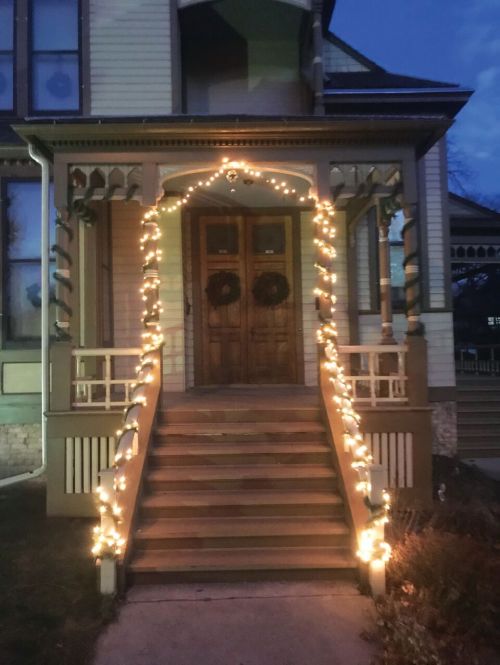News | December 20th, 2017
 Local history goes with Christmas, doesn’t it? And this Christmas there are tours of one of Moorhead’s most historical sites, Comstock House, richly decorated for the occasion.
Local history goes with Christmas, doesn’t it? And this Christmas there are tours of one of Moorhead’s most historical sites, Comstock House, richly decorated for the occasion.
We were concerned that many people don’t realize how much goes into these special tours. Matt Eidem, Director of Museum Operations of the Historical and Cultural Society of Clay County, was kind enough to take time off from his duties to fill us in.
High Plains Reader: Who were the Comstocks and why were they so significant to Cass County?
Matt Eidem: Solomon Comstock was an early settler of the area and Clay County’s first County Attorney. After serving in the Minnesota Senate for awhile he met James J. Hill, who hired Comstock to plot towns along the railroad, and that job spurred Comstock to start a real estate company to go along with his legal career.
One of his claims to fame is donating the land to the state where the Minnesota Normal school was built (MSUM). He also donated the land to the Episcopal church where they built Bishop Whipple School. After Bishop Whipple went out of business the Lutherans bought it and turned it into Concordia.
His wife Sarah was very involved in the community as well. She was one of the original members of the Moorhead Women’s Club in 1893, and was also the driving force behind bringing the first public library to town.
Their oldest daughter Ada was a big deal nationally in higher education. She was the first Dean of Women at U of M, where there is a dorm named after her, she was the first full-time president of Radcliffe College, and served on a White House Committee in the 20’s.
HPR: Who built the Comstock house? What are the most significant points of the building architecturally? What is distinctive about the Queen Anne style of architecture -- or rather, what makes it recognizable?
ME: The Comstock House was designed by Kees and Fisk, a Minneapolis firm, and built by local contractors. It’s a Queen Anne/Eastlake style. The main giveaway for what makes it a Queen Anne House are probably the porches. There’s one on the front, the side, and a 2nd floor porch on the front. The Bay window on the south side and the wooden shingles also are Queen Anne. The Eastlake influences are mostly on the inside: some spindle work in the entryway and a lot of their old furniture.
HPR: How and why were the house and artifacts so intact once the county acquired it?
ME: The house was donated to the Minnesota Historical Society in 1965 by George Comstock and Frances Frazier Comstock. When they gave it to them, they gave the furniture with it with the hopes of it all being used to “interpret history.” The Minnesota Historical Society still owns the house and the contents. They contract with us to operate the house and provide programming, since we’re here and they’re in St. Paul.
HPR: Christmas and Victorian traditions: How did the Victorians impact modern Christmas traditions?
ME: Since we’re a country of immigrants, a lot of our traditions are rooted in our European ancestors, especially the British and the Germans, whose traditions would hit the East Coast, then come west as people moved this way.
HPR: What traditions have remained relatively intact?
ME: Christmas Trees were a German thing and when Queen Victoria married Prince Albert, who was German, he brought, that tradition to the palace and it spread to the rest of British society. Trees took off in England after this engraving of Albert, Victoria, and their children appeared in a London publication in 1848.
By 1856 the first Christmas Tree is being put up in the White House. On the Comstock House tour, we’ll also talk about the origins of gingerbread houses, sugar cookies, mistletoe, and get into some Victorian Table etiquette, among other things.
HPR: Were there traditions that may seem surprising by today's standards?
ME: Not really. I think some people, especially younger ones, are surprised by how simple things were, but a lot of what they did is still done.
HPR: Can you tell us a bit about the Victorian Parlor games mentioned in the press release?
ME: On the tour, we’ll introduce a few games and actually play a few rounds of pass the slipper, and charades. For pass the slipper, pick a player who stands in the center of a circle formed by the other players. The player in the middle must close her eyes and as she does, so the slipper is passed from player to player behind the backs of the players in the circle. When the person in the middle opens her eyes, the passing of the slipper immediately stops and the player must guess who holds the slipper. If she is correct, the two change places; otherwise the player closes her eyes again and play continues.”
In Victorian times they would have used a slipper, of course, but we’ll be passing a candy cane. Charades was the same game we play today when we play charades.
HPR: What did the Victorians do for fun?
ME: It was a world before TV, and for part of it, even radio, so what they did for fun was read books, play board games, and interact with each other. Imagination was incredibly important to having a good time.
HPR: As a historian and one who works closely with the Comstock history, what do you find most interesting about the Comstock House?
ME: The most interesting thing is how much history of Moorhead and of that era you can tell just from interacting with the space and looking at the lives of the family. When looking at Solomon Comstock, you can talk about the railroads, labor, and the development of the town. With Sarah and his daughters, you can bring in the importance of literacy to the community, and look at women’s issues of the time. With their servants to it’s possible to bring in the lives of the working class in Moorhead.
HPR: What other kinds of programming can guests anticipate from the Comstock house?
ME: A lot of our programming is designed to create opportunities for our area students to show their skills or share their research, so through the school year we have speakers and monthly music recitals with students from the Concordia Music Department. The one I’m most excited about is Dr. Ashley Baggett, an NDSU professor, who will be talking about Progressive Era women’s movements in March.
For tickets to Professor Baggett’s event, please visit eventbrite.com/e/progressive-era-women-public-housekeeping-and-beyond-tickets-39670921795
The summers are reserved for weekly yoga classes and bi-weekly lawn game nights. The best way to stay on top of programming at the Comstock House is to check our website at HCSCConline.org.
IF YOU GO
Comstock Christmas Light Tours
Saturday, December 23, 5:30, 7, and 8:30pm
Comstock House, 506 8th St S, Moorhead
3 tours, limit 12 people per tour. 701-291-4211
June 9th 2025
April 30th 2025
April 24th 2025
April 23rd 2025
April 21st 2025

__293px-wide.jpg)



